Affiliate disclosure: This post may contain affiliate links. Please see our Privacy Policy.
Herbalists know that burdock root is powerful medicine, but most would be surprised to learn that the burdock is edible as well. Burdock leaves, stalks and roots are edible and can be downright tasty if you know how to prepare them.
If you’ve walked by a burdock plant in the fall, you know how the plant gets its name. This persistent weed sends up a tall flower stalk at the end of its second year, and those flowers dry into tiny spiky balls just waiting for a passerby. Most people hate them, and for good reason. The barbed spikes on the seed pods are hard to remove, and they stick to just about everything. Hopefully, once you learn that burdock both edible and medicinal, you may learn to appreciate this much-hated herb.
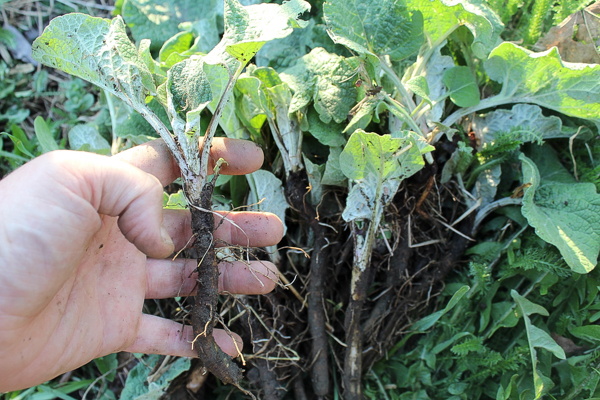
Where to Find Burdock Plants
Burdock plants tend to colonize along the edge of walking paths where both humans an animals can pick up and deposit their seeds. They stick to pant legs, shoelaces and they barb right into my fingers when I try to remove them. My two-year-old daughter picked up about a dozen burdock balls on her pants, each with dozens of individual seeds.
Not thinking, I stopped along the path between our rhubarb bed and grape arbor and removed all the tiny stickers from her pants. The next year, in that spot, just about every one of those burdock seeds sprouted. Right in the middle of a walking path near my perennials is a horrible place for burdock, so it’s time to get out the spade.
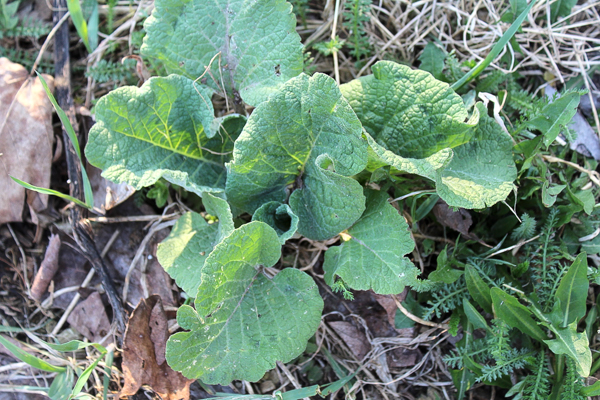
When to Harvest Burdock
Since Burdock is a biennial, the root is generally harvested in the fall at the end of its first year or growth or in its second spring before it sends up a shoot. In its second year of growth, burdock uses the energy reserves in its root to send up a tall flower spike. By the fall of its second year, burdock is putting out sticky burr seed packets, and the plant dried out and dies back completely.
Even though burdock is generally harvested in its first fall or second spring, burdock grows quickly. There’s enough root material to harvest even after just a few months of growth. The handful of burdock plants below are about 3 months old, and they already have several inches of usable taproot.
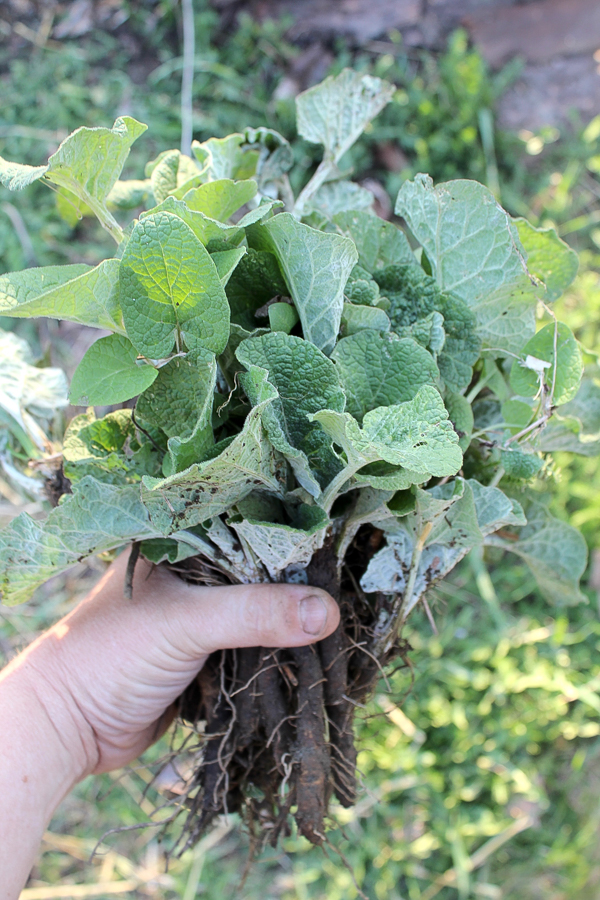
If I had waited until the fall, these roots would be several feet long and up to 2 inches in diameter. While that’s a much bigger harvest, they’d also be extremely hard to dig up. Burdock plants are notoriously difficult to uproot once they’re mature. Since these young plants were going to be removed from my walking path anyway, I’m happy to have a whatever harvest I can get.
Burdock Leaves
If you keep your eye out in the very early spring, well before the last frost, you can spot the burdock seedlings emerging from the soil before most other greenery. I spotted my burdock patch and watched them carefully for a few months before the harvest. Since the leaves are edible when they’re very small, they’re an easy to identify spring potherb. They tend to be bitter, but less so when they’re small.
Eat the Weeds suggests using large burdock leaves to wrap foods for campfire cooking. While they may not be tasty alone, they’re technically edible (not toxic) and won’t contribute much flavor to the foods they’re wrapped around. This will keep things clean and neat during cooking, and allow you to cook with minimal equipment.
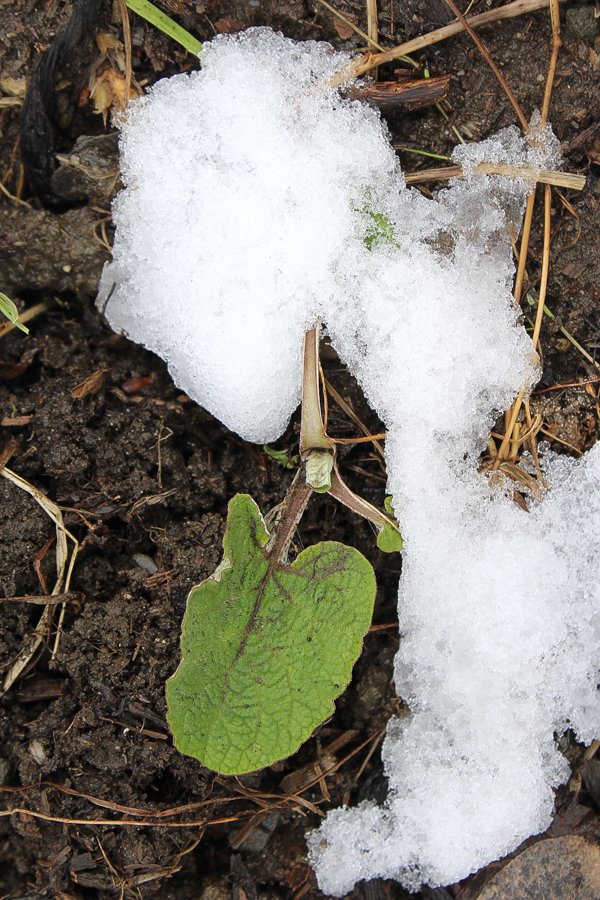
Burdock Roots
While burdock root may seem like a crazy wild edible, it’s actually a cultivated edible in many parts of the world. In Asian countries, it’s called Gobo, and I’ve actually seen it at our local farmer’s market. One of the farmers that sells it says he has a good demand for it, though he personally thinks it tastes like dirt.
I agree, I think it tastes like dirt. It’s bitter, but that’s not the issue. To my palate, it actually tastes like eating dirt. Saying it has an “earthy” flavor doesn’t cover it. Dirt. That’s what it tastes like. To me anyway.
My husband, on the other hand, loves it. Half the world, mostly in the east, also love it. I’m in the minority and you should try it for yourself and decide. It’s traditionally peeled, sliced thin and added to stir-fries. It’s also pickled like daikon. My friend Colleen at Grow Forage Cook Ferment tosses it with olive oil and salt before roasting it on a pan. She doesn’t even peel it!
“Roasting it is my favorite way to cook [burdock root]. I actually like the flavor of the skin, as I find it adds a certain nuttiness that is really amazing. I just make sure to wash the roots really well to get all the dirt and grit off, just like you would with a potato. Then I slice the root into rounds.”
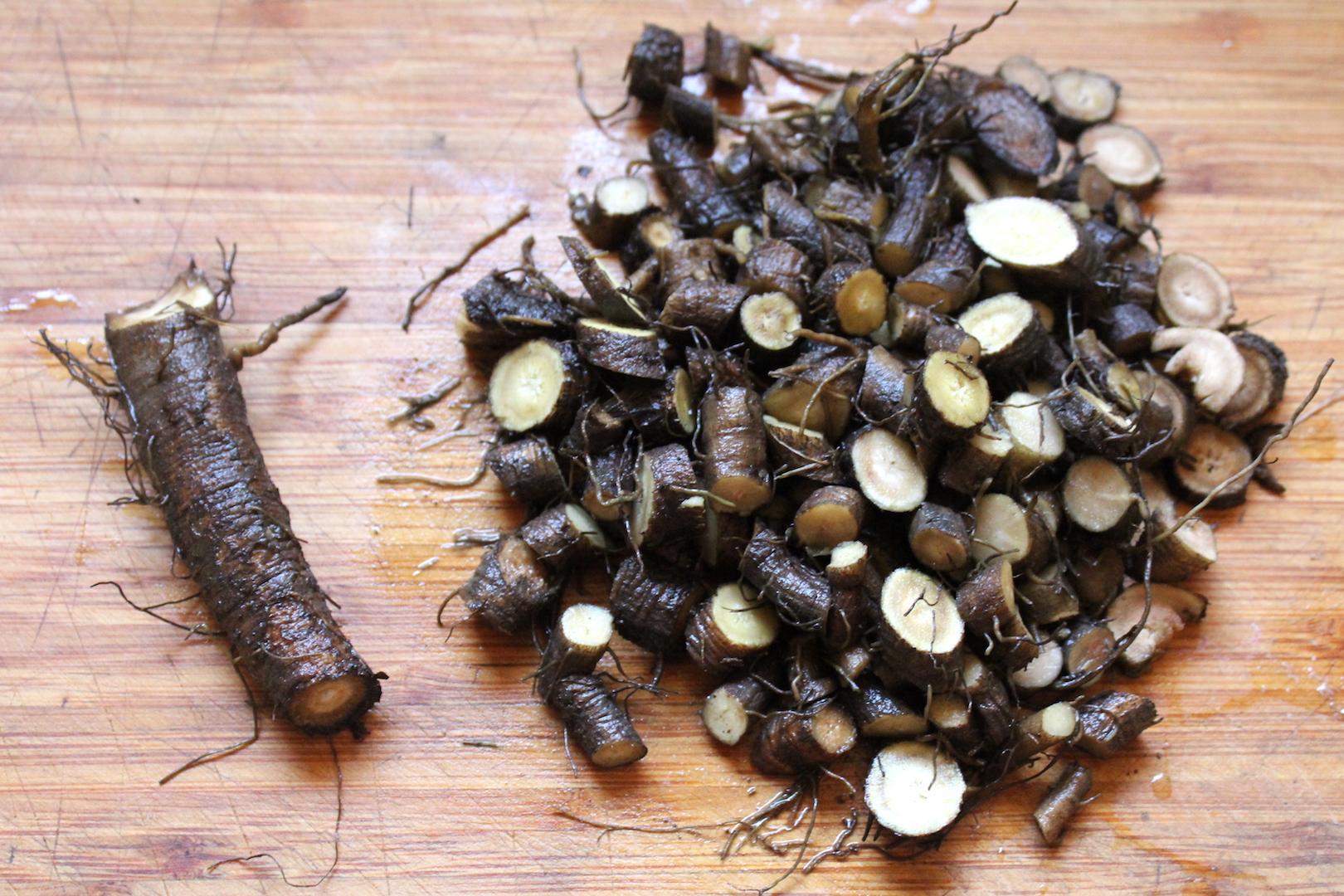
Beyond its use as a vegetable, burdock root is medicinal. Though I don’t eat it, I’ve had miraculous success using burdock tincture as an anti-inflammatory. It saved me an emergency room trip as my throat was closing up due to swollen lymph nodes, and I keep it around for any condition that needs lymph or swelling to drain quickly.
I also make a burdock vinegar every year for my husband, and he drinks it straight. Just a jar full of sliced burdock covered with raw apple cider vinegar and left to infuse for a few months. I then strain it out, and he eats the burdock roots as pickles. He’ll pour the infused burdock vinegar into a shot glass and drink it anytime he as a bit of stomach upset, and reminds me to make more when we run low. I can’t imagine how he stomachs it, just the smell makes me queasy. One person’s medicine is another’s poison, and it works for him.
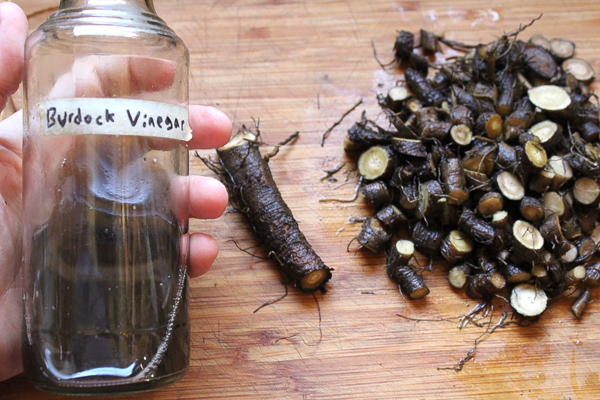
Burdock Flower Stalks
In my opinion, the best part of burdock is the edible flower stalk. It’s tricky to catch the burdock plant at the right stage for harvest. Too late in the year and the burdock stalk will be too fibrous. Too early and there just isn’t much stalk available to harvest.
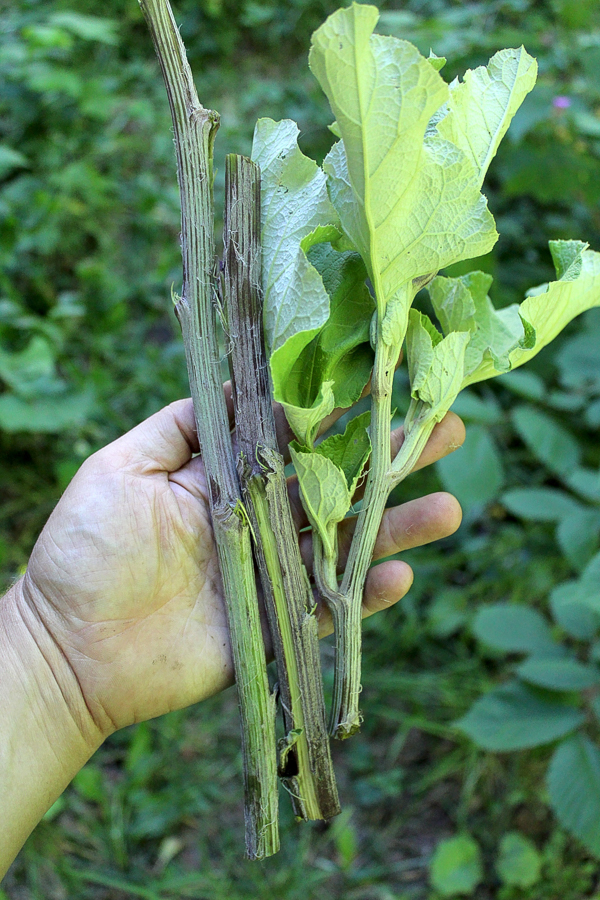
I remember reading at some point that burdock flower stalks need to be harvested before the central stalk develops a hollow part in the center. The stalk has a fibrous outside and a soft pithy center. As the plant gets older, the stalk will develop a hollow center and the soft center will dry out as the stalk becomes increasingly fibrous.
The burdock flower stalks I found had solid centers, with no hint of hollowing. Sweet!
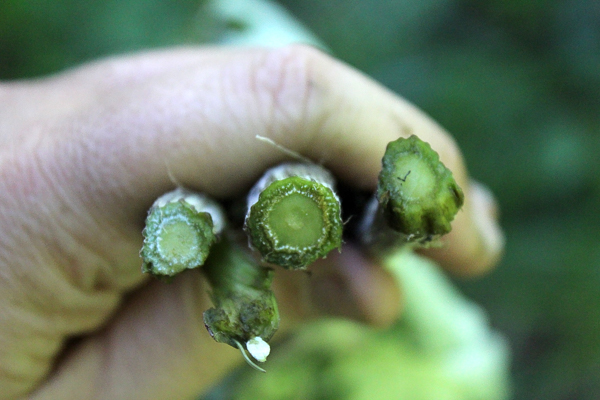
Generally, once a biennial goes to seed, it’s too late to harvest just about any part. For example, thistle stalks, leaves, and roots are edible, but only if you harvest them before the flowers develop. The same is true of burdock. Once the flowers develop, just about every part, including the stalk, becomes unpalatable.
Forager Chef has a number of great recipes for burdock flower stalk, but cautions that it’s all about timing,
“When I got to the burdock patch, I noticed that the plants had started forming their seed heads (the cock-a-burs) and it was harder to cut through the base of the stalk. In hindsight, I should’ve known I’d missed the mark. Like so many other plants, when the reproductive cycle starts, some of the edible parts of the plant become less edible, or in the case of burdock flower shoots, completely inedible. The shoots cooked up stringy, fibrous, and horrible. Timing is everything.”
The first step is to peel the burdock flower stalk, and I used my pocket knife to peel off the stringy exterior. The remaining stalk was still rigid and a bit stringy, but it went right into the pot.
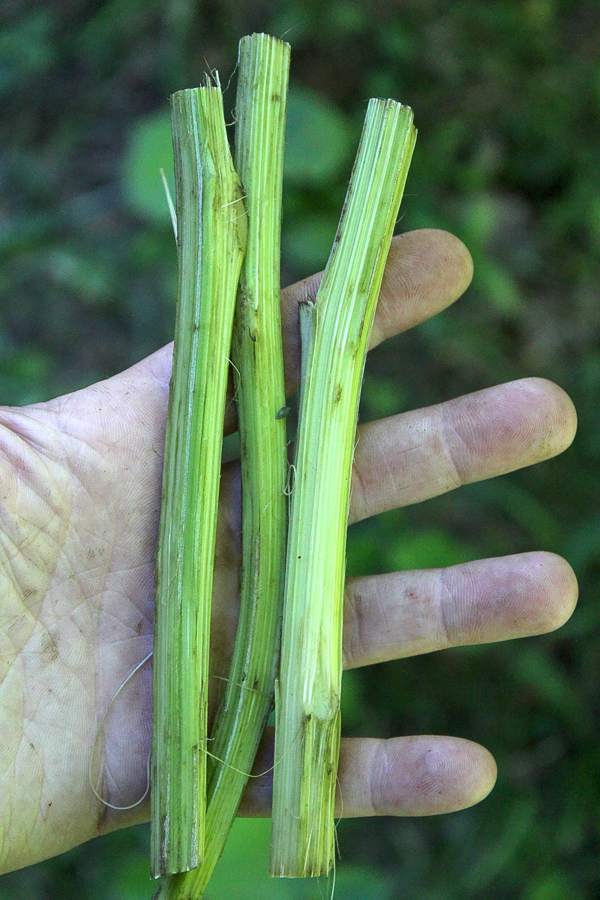
A quick boil, and I’ll be honest, I was unimpressed. The exterior of the stalk is still bitter and really tough. Perhaps I didn’t cook it long enough, but I couldn’t get my teeth through it. A bit more research and I learned that burdock flower stalk needs to be peeled twice!
The first peel gets the outer skin off, and then the second peel gets the tough and stringy outer layer off. That leaves the sweet and tender core, which is the best part of the burdock. This video is a great tutorial on what you’re going for peeling burdock flower shoots.
I hadn’t peeled mine twice before cooking, and that left the bitter and tough outer fiber layers intact. I opened up a small section of the cooked burdock flower stalk to expose the tender interior and scraped off a taste with my teeth. Delicious!
It was soft and smooth, and tasted exactly like the steamed artichokes my mom made on special occasions as a kid. When you cook a whole artichoke, each leaf pulls off with a teeny tiny bit of tasty artichoke flesh attached. The leaf itself is unpalatable, but you can dip it in butter and use your teeth to scrape off the tender flesh. The inside of the burdock flower stalk tasted exactly like that. Creamy, buttery and sweet without any hint of bitterness.
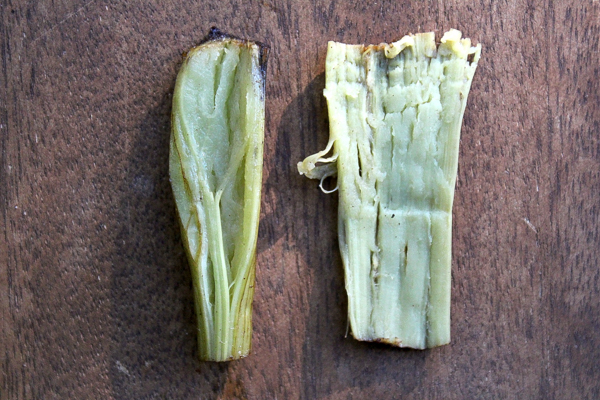
Burdock Flowers
Just about every part of the burdock plant becomes bitter and unpalatable once the plant goes to flower. I’ve wondered if the burdock flowers themselves might be edible at some stage in their development. Thistle flowers are quite similar, and they’re edible when very small before the pink portion blossoms out.
I went through the process of harvesting small thistle flowers, and it was an unholy pain that I’m not eager to repeat. In the end, thistles yield a very small (1/2 inch) vegetable that’s a bit like an artichoke heart. That’s after a lot of stickers and careful peeling. Burdock flowers are much smaller, and knowing what I know about thistle flowers, I’d likely lose a finger trying to carefully peel one out.
It’s also tricky to catch them at the right stage before they’ve blossomed. When they’re blooming in the fall, there’s plenty of other wild food sources, and it’s just not worth it. I think burdock flowers are one of those edibles best left to the bees.
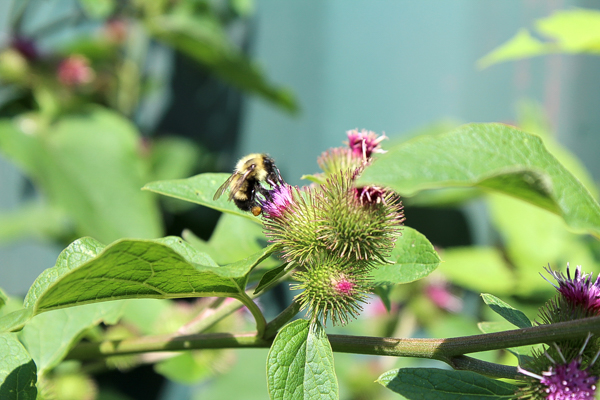
Burdock Recipes
There you have it. Every part of the burdock plant, ready for either food of medicine. If you’re looking for more inspiration, check out any of these recipes using wild foraged burdock:
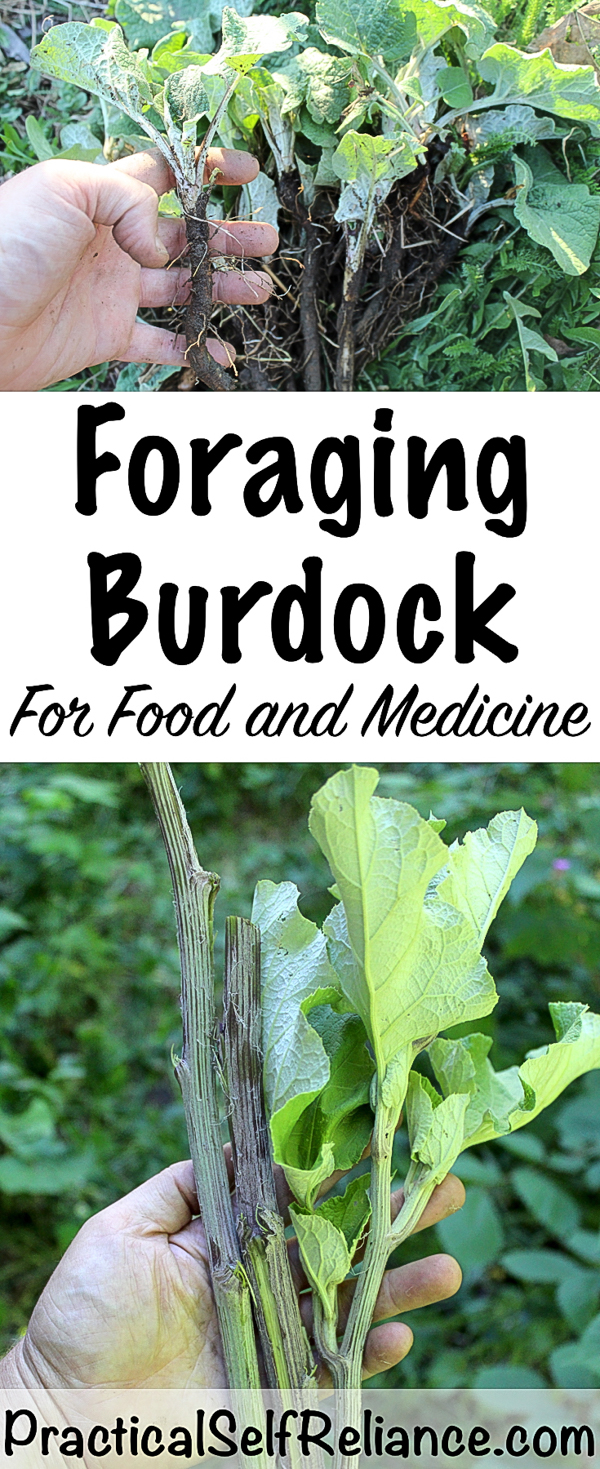


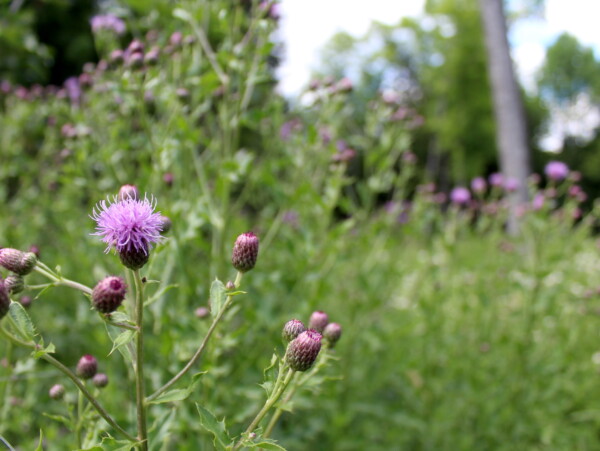
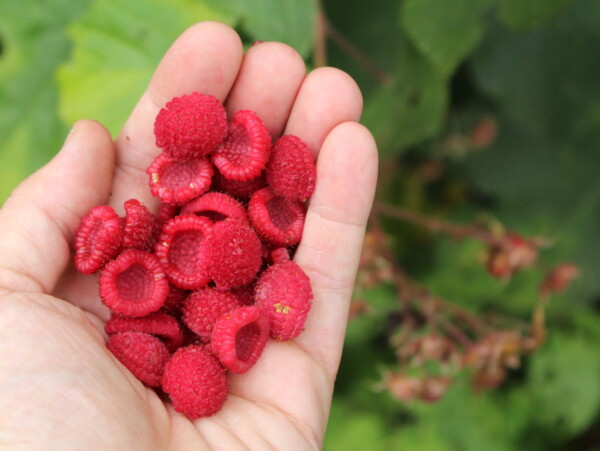










Thank you with all my heart! 💖
I adore burdock root sautéed with carrots in coconut oil ( and butter if you like). Peel and cut gobo and carrots into regularly sized 1/4 inch matchsticks. Toss in a cast iron pan coconut oil and butter. Salt or seaweed sub can be added.
Cook over low to medium heat stirring often ( really often – best stick around and drink a glass of something while chatting with a lived one). Keep this up for 20-30 minutes or until they are tender but not squishy. You might need to add the carrots in later on in the game to avoid mushy carrots.
I like them with salt and pepper, tho’ soy sauce is a delicious addition, too. The sweet carrot and coconut oil and the slow cooking adds a perfect foil for a gently “piney” and earthy flavor. ( to me no more earthy than beet root or parsnip!).
After making a tincture, are there any medicinal properties left in the Burdock root? I’ve always read to compost or discard the roots, but it seems like such a waste.
I would say that most of the beneficial properties have been pulled out during the infusion but maybe you could incorporate them into a stir fry or sautee them and eat them.
Thank you for so much information. I live in Australia and have never seen wild burdock. I was thrilled to find a seedling at a nursery recently. I don’t know that I would be able to buy it again and I like to propagate as many things as I can anyway. I gather that if I wait until the plant seeds it will be inedible, which would mean I would not have a crop until at least the 3rd year, growing from the seed.. I am wondering if I can let it go to seed but take some of the root off in the first year? I only have one plant, maybe I should have bought more.
That’s correct, if you wait until it seeds it’ll be inedible. Honestly though, I’m not sure if it needs cross pollination from another plant to seed? Maybe, or maybe not? It’s never an issue here since it’s so common, there’d never be just one…
You can get the seeds though, there’s a company called strictly medicinal seeds that sells seeds for multiple varieties: https://strictlymedicinalseeds.com/?s=burdock&post_type=product&title=1&excerpt=1&content=1&categories=1&attributes=1&tags=1&sku=1&ixwps=1
I like Burdock Tea. I also like to put Burdock and Nettle in the pot to make bone broth.
That sounds delicious!
This is one of the best descriptions of burdock and how to harvest and use it for both food and medicine that I’ve come across. Thank you!
You’re very welcome Char. Glad you enjoyed it.
Burdock root is one of my favorite veggies! I lived in Japan for many years. Try washing it and slicing it diagonally into sections then boil it in water with the Japanese Trinity… Soy sauce, Mirin and Sake. It takes a while as it is tough. You can eat it like this, or throw in some carrots and chicken (thighs or legs with or without bones is best) and you have nimono which is a great meal especially when it’s cold out.
That sounds delicious!
I read that common burdock is not a native plant and is highly invasive. I’ve been debating about taking out the plant that is growing in my yard. I think I will, especially since burdock tea make me feel sick to my stomach.
hmm, try preparing it with other methods using different parts of the plant.
With the amount of beneficial health properties of burdock, I’ll let it invade all over baby
We have a farm with these popping up everywhere. I did not know what they were until today and I have been trying to learn as much as I can. How do you know if you have a first or second year plant? Can you eat the stems and roots of either year? Any help is appreciated.
They’re edible at any time in either year, and the leaves are also edible at any stage (they’re fermented like kraut or just cooked as they are when young) They’ll only send up a shoot in the 2nd year, so that’s a dead giveaway. First year plants sprout much smaller leaves in the spring, and they’ll stay relatively low all the 1st year. Second-year plants sprout big leaves in the spring and quickly begin working on sending up a flower stalk.
Roots on 1st year plants are also quite small until late in the fall, and 2nd year plants can have massive roots 2+ feet long and really thick.
Hope this helps!
I can’t believe I’ve been pulling these up and tossing them because of the burs! I hope I didn’t trash ’em all! Thanks for the info!